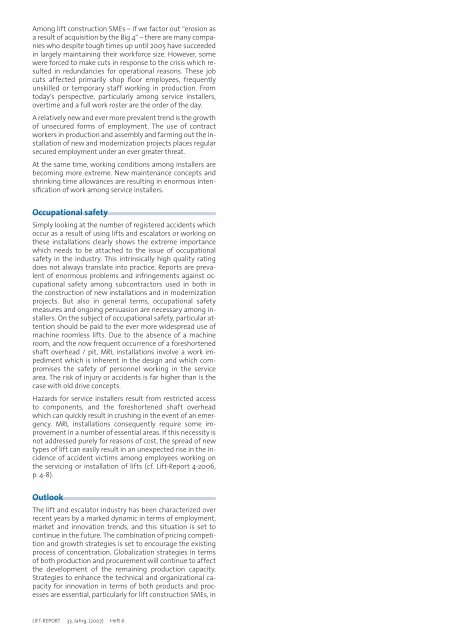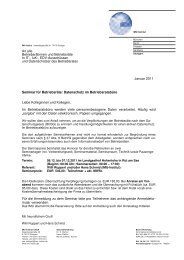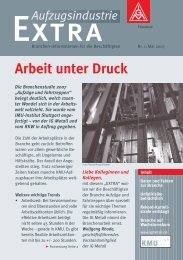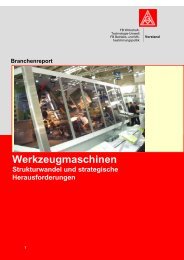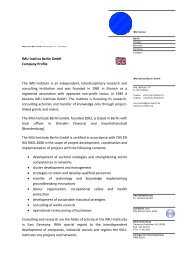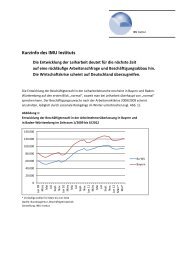Aufzüge und Fahrtreppen - IMU Institut
Aufzüge und Fahrtreppen - IMU Institut
Aufzüge und Fahrtreppen - IMU Institut
Erfolgreiche ePaper selbst erstellen
Machen Sie aus Ihren PDF Publikationen ein blätterbares Flipbook mit unserer einzigartigen Google optimierten e-Paper Software.
Among lift construction SMEs – if we factor out “erosion as<br />
a result of acquisition by the Big 4” – there are many companies<br />
who despite tough times up until 2005 have succeeded<br />
in largely maintaining their workforce size. However, some<br />
were forced to make cuts in response to the crisis which resulted<br />
in red<strong>und</strong>ancies for operational reasons. These job<br />
cuts affected primarily shop fl oor employees, frequently<br />
unskilled or temporary staff working in production. From<br />
today’s perspective, particularly among service installers,<br />
overtime and a full work roster are the order of the day.<br />
A relatively new and ever more prevalent trend is the growth<br />
of unsecured forms of employment. The use of contract<br />
workers in production and assembly and farming out the installation<br />
of new and modernization projects places regular<br />
secured employment <strong>und</strong>er an ever greater threat.<br />
At the same time, working conditions among installers are<br />
becoming more extreme. New maintenance concepts and<br />
shrinking time allowances are resulting in enormous intensifi<br />
cation of work among service installers.<br />
Occupational safety<br />
Simply looking at the number of registered accidents which<br />
occur as a result of using lifts and escalators or working on<br />
these installations clearly shows the extreme importance<br />
which needs to be attached to the issue of occupational<br />
safety in the industry. This intrinsically high quality rating<br />
does not always translate into practice. Reports are prevalent<br />
of enormous problems and infringements against occupational<br />
safety among subcontractors used in both in<br />
the construction of new installations and in modernization<br />
projects. But also in general terms, occupational safety<br />
measures and ongoing persuasion are necessary among installers.<br />
On the subject of occupational safety, particular attention<br />
should be paid to the ever more widespread use of<br />
machine roomless lifts. Due to the absence of a machine<br />
room, and the now frequent occurrence of a foreshortened<br />
shaft overhead / pit, MRL installations involve a work impediment<br />
which is inherent in the design and which compromises<br />
the safety of personnel working in the service<br />
area . The risk of injury or accidents is far higher than is the<br />
case with old drive concepts.<br />
Hazards for service installers result from restricted access<br />
to components, and the foreshortened shaft overhead<br />
which can quickly result in crushing in the event of an emergency.<br />
MRL installations consequently require some improvement<br />
in a number of essential areas. If this necessity is<br />
not addressed purely for reasons of cost, the spread of new<br />
types of lift can easily result in an unexpected rise in the incidence<br />
of accident victims among employees working on<br />
the servicing or installation of lifts (cf. Lift-Report 4-2006,<br />
p. 4-8).<br />
Outlook<br />
The lift and escalator industry has been characterized over<br />
recent years by a marked dynamic in terms of employment,<br />
market and innovation trends, and this situation is set to<br />
continue in the future. The combination of pricing competition<br />
and growth strategies is set to encourage the existing<br />
process of concentration. Globalization strategies in terms<br />
of both production and procurement will continue to affect<br />
the development of the remaining production capacity.<br />
Strategies to enhance the technical and organizational capacity<br />
for innovation in terms of both products and processes<br />
are essential, particularly for lift construction SMEs, in<br />
LIFT-REPORT 33. Jahrg. (2007) Heft 6 37


